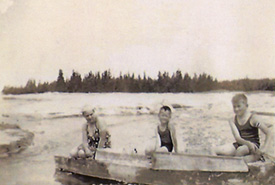Cherishing memories of Port Joli

Cabin of Benjamin H. Annis in Port Joli, NS (Photo courtesy of Cal Annis)
Ever wondered where Port Joli gets its name from? The French word “joli” translates to lovely and pleasant in English. But does Port Joli represent its name accurately? We believe it does.
Located about 20 kilometres from Liverpool, Port Joli is a beautiful, isolated community. Thanks to its coastal climate, Port Joli forests include a variety of rare and endangered lichens, such as boreal felt lichen, vole ears lichen, blue felt lichen, and black foam lichen. As one of the few areas in Atlantic Canada to host these rare and endangered lichens, the Port Joli nature reserve is recognized as a valuable and significant asset to the province. The area is also home to the Kejimkujik National Park Seaside, cultural treasures that hold 4,000 years of Mi’kmaq history.
Cal (Calvin) Annis is a native Nova Scotian now living in Alberta. He still cherishes his childhood memories of Port Joli, on the south shore of Nova Scotia. Cal taught Grades three and four in rural Nova Scotia. While attending Acadia University for his Professional Nova Scotia Teaching Certificate, he met his first wife, Rosalind. After seeing a newspaper advertisement looking for teachers in Alberta, they moved to Alberta in 1958 where Cal began teaching in Tofield, a rural community just over 100 kilometers east of Edmonton.
For Cal, Port Joli is more than just a location; it’s where his family vacationed in the summer months when he was a child. Thanks to the wonderful memories of his grandfather’s cabin, he still feels close and connected to this beautiful piece of southwest Nova Scotia.

Cal with his brother and cousin, Port Joli ((Photo courtesy of Cal Annis)
“Grandfather owned a small rustic cabin on a low bluff overlooking the white sandy beach at the head of the bay. Because of the limited sleeping accommodation in the cabin, we young people always bunked in a tent outside. I remember looking forward to retiring and drifting off to dreamland, lulled by the unforgettable sound of ocean waves caressing the sand just a few feet away,” says Cal.
The area around Cal's family cabin was also enjoyed by the local wildlife. Cal writes about his grandfather seeing moose (endangered on mainland Nova Scotia), squirrels, shore birds, and porcupines from time to time.
Cal recalls reading about Port Joli in the 2017 spring issue of the Nature Conservancy of Canada Magazine. The article “Coastal Roots” by Sandra Phinney highlights the beauty of Port Joli and the importance of conservation in Atlantic Canada. “I can't describe how wonderful I felt when I saw in the magazine that Port Joli was to be an area protected from development. I love that part of Nova Scotia because my family's roots were in that part of the province. Although I never lived in Queens County, it is still like going home when I have the chance to visit,” says Cal.
Later in 2017, Cal met with NCC (Nature Conservancy of Canada) Nova Scotia staff to learn more about the conservation work and discuss a site visit to locate where his grandfather’s cabin was. Cal and his sister Lena Millar visited Port Joli and were thrilled to reconnect with a place held so dear to them. Unfortunately, they were unable to locate any signs of the cabin’s location.
The Annis family's love and appreciation for nature comes from a long history of caring for the environment. “My grandfather (Benjamin Annis) was an early Nova Scotian naturalist. His working days were spent in the woods working as a timber cruiser (forest management). This fostered his love of nature and its inhabitants. During his lifetime, he wrote extensively in poetry and prose about preserving nature’s habitat for its wild creatures and the environment, for present and future generations to enjoy,” says Cal.
Being connected to nature gave Cal’s grandfather the inspiration to look for and create fascinating sculptures made from objects he found in nature. With his vivid imagination, Benjamin created characters that he studied while reading, and no special materials were needed. He mostly used “old dry roots, pieces of driftwood, or ‘old man's whiskers' (beard lichens) hanging from a dead branch. Everything that he saw, collected, or created from his imagination, both in his working life and during his retirement years, was the result of his close association with his natural surroundings,” says Cal. From this, Cal began to appreciate the beauty and importance that the natural world held. He took this lesson of appreciation throughout his life. He is now helping to ensure that Port Joli will stay in the condition he remembered as a child for generations to come.
Since 2006, NCC has been working on conserving land in Port Joli and surrounding areas. Whether it is through art or poetry inspired by the area, the family continues to appreciate the land:
“I am sure if my grandfather were alive today, he would be a dedicated and enthusiastic supporter of the Nature Conservancy of Canada. He would be, as I am, immensely proud that the beautiful and vibrant Port Joli region of our home province will be protected for posterity,” says Cal.
Help us protect more of Port Joli and surrounding coastal areas. Learn more.




